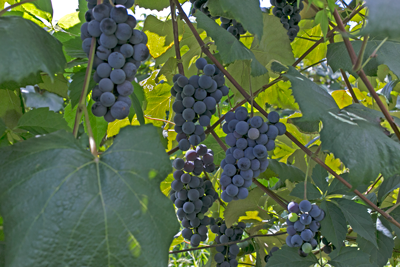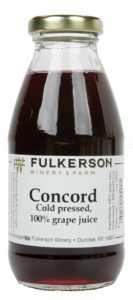
| Family | Grape |
|---|---|
| Type | Red, Heritage (Native) |
| Availability | Sold-out |
| U-Pick Price | $0.55 |
| Juice Price | $6.00 |
| Crushed Price | 0.90 |
Availability: Sep 19 - Oct 13
About Concord Grapes
The Concord grape was developed in 1849 by Ephraim Wales Bull in Concord, Massachusetts. The pollen parent is unknown. Although Concord is frequently considered to be basically a Vitis labrusca cultivar, some have argued that the hermaphrodite flowers suggest at least a small amount of Vitis vinifera in its pedigree. This trait has not been proven to exist in any native American grapes. However, Concord is definitely much more labrusca-like in its characteristics than vinifera-like. Some consider the likely male parent to have been Catawba.
The skin of Concord grapes is typically dark blue or purple and often is covered with a waxy coating that is easily removed. It is a slip-skin grape variety, allowing for easy separation from the fruit. The grapes have large seeds and are highly aromatic but are prone to the physiological disorder black spot.
Flavor
Concord grapes are highly aromatic, tangy, and sweet with a unique musky flavor. When consumed as table grapes, they are often considered tart. Concord grapes contain a chemical compound known as methyl anthranilate, which is used to artificially flavor beverages and candy. Their intense flavor pairs well with rich, creamy desserts such as pies, cheesecake, or pannacotta, and, of course, peanut butter. Other complementary flavors include nuts (almond, pistachio, hazelnut, walnut, peanut), fruits (lemon, strawberry, raspberry), herbs (endive, arugula, fennel, rosemary, mint), dairy products (yogurt, sour cream, crème fraiche, goat cheese, blue cheese), and meats (pork, duck, and poultry).
Uses
Concord grapes have a wide variety of uses including making preserves, juice, wine, liqueur, and vinegar. Of those uses, they are most notably used for making grape jelly. When you think of a classic PB&J, they are the grapes used to make the jelly, making them a staple product in U.S. supermarkets. They are also sometimes available for outright eating as a table grape, especially in the New England area. They are also quite popular for making grape juice (like we do at Fulkerson), and it is their distinctive purple coloring that has led to many grape-flavored drinks and candy being artificially colored purple.
Concord grapes have also been used to make kosher and sacramental wine, as well as traditional wines. In fact, O-Neh-Da Vineyard, the oldest sacramental winery in America, still produces a Concord altar wine.

Recommendations:
9/19/24: brix: 15.5, TA: 0.748, pH: 3.23
9/19/24: brix: 16.4, TA: 0.83, pH: 3.24
10/4/24: brix: 18.1, TA: 0.69, pH: 3.28
10/11/24: brix: 18.4, TA: 0.83, pH: 3.33
